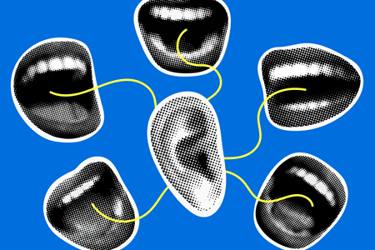Pharma's Guide To Making Health Communications Land Well
By Michelle Bridenbaker

The way the pharma industry communicates its value to the market has never been more important, as its propositions, including the latest biologic therapies, become more ambitious and complex. A major challenge for companies is how to be heard above the market noise, which has now reached a peak. In today’s “attention economy,” human brain-space is a limited resource which all communicators must ‘earn’ — whether they are pharma/medical device industry communicators, or social media health communicators.
When trying to reach overstretched healthcare professionals, companies are competing for the scarcest amount of time to engage and educate. To reach patients and their families, meanwhile, brands must also compete with an ocean of disinformation being spread daily across the internet and social media, not least by self-declared “health influencers.” Breaking through all of this ‘noise,’ with targeted and credible messaging that hits its mark, is no mean feat.
Omni-channel Strategies Are A Distraction
“Omnichannel” communications strategies have been a big focus in recent years, as companies have sought to reach the different stakeholder groups (regulators, investors, payers, healthcare providers, and patients) with messaging that resonates, in an appropriate format, distributed across the optimum combination of channels. Too often, however, such campaigns have been approached from a “cover all bases” mentality. Messaging has not been joined up, and there has not been enough thought about meeting healthcare professionals, or patients and carers, where they are.
In a strictly regulated environment, which imposes limits on how and when claims or information that can be conveyed, the omni-channel obsession can be a distraction from what’s really needed. A multi-channel approach may well be advisable, but the greater priority should be to use the target channels appropriately; in other words, to get the right information out there, educate the market, and engage audiences with science in a consumable way.
This requires agility as much as anything: the ability to respond swiftly to themes or concerns that are trending online or in the news, for instance. It also requires skill in communicating the facts: the evidence-based science. All of this starts with thoughtful engagement, based on a richer understanding of who the various customer stakeholders are and what exactly they need (and in what context).
Meeting “Customers” Where They Are
Consider the life of a doctor in the 2020s. Indeed, the vast majority of healthcare professionals around the world today are time-starved and highly stressed. A 2022 survey from the AMA, Mayo Clinic and Stanford Medicine found 63% of physicians had experienced symptoms of burnout in 2021, up from 38% the previous year – a legacy of the COVID-19 pandemic that has not really gone away. Other studies suggest that more than half are on the verge of leaving the profession.
Although doctors are fully aware of the need to keep up-to-date with the latest scientific developments and medicinal breakthroughs, volumes of information are now doubling at least every 73 days, and the time and attention to absorb new information is already scarce. There is no capacity for learning about new products during a busy shift; the chance to engage is more often limited to snatched hours of personal downtime at home.
It makes sense to “meet” them there, then, via constructive use of social media, and/or targeted use of the online forums and educational sources they trust – such as Sermo, a social network for doctors; Medscape; PubMed; the NIH; and the WHO. Other discovery options include Consensus, an AI-based search app which scans research papers.
Currently, compared to other intensely competitive markets such as retail, the pharma industry is behind the curve when it comes to meeting ‘customers’ where they are. Although 82% of healthcare professionals consider global independent medical websites a very important or critical source of scientific content, for instance, less than 50% of pharma communicators recognize this. Where the pharma industry still looks for face-to-face time with clinicians, healthcare professionals are stating preferences for more convenient digital engagement, particularly in the post-lockdown era.
Digital Channels’ Great Advantage: Consumption Data
Having identified where physicians go, the next challenge is to determine how best to engage them there. One of the advantages of digital channels is the ability to track engagement levels: usage data will show which content, delivered in which format, when, and via what means, is enjoying the most traction.
The same applies to patients and their families or carers. Reliable data analytics are important to understand where audiences go for their information, and the kinds of content they engage with (and share) most readily. These insights are important to inform targeted content decisions. For every scare story or factually-inaccurate groundswell of opinion that spreads on social media, there needs to be a reliable counterpoint; a reassuring base of scientific fact and reason to which the public can return.
Making Messaging More Consumable
When audiences are time poor and being bombarded by conflicting information, often the greatest need is for quick clarity. In a public health context, that might be best served by a carefully crafted infographic, or an authoritative podcast, setting out the scientific facts (with source references) in a readily digestible way: to counter vaccine hesitancy, or boost treatment or diet plan adherence, for example. For an overstretched physician, evidence-based summaries or peer preferences can be more powerful than advertising brochures or in-depth clinical papers for capturing initial attention.
Organizationally and culturally, the call for more sophisticated communications strategies requires a rethink internally within pharma companies. Target audiences typically are not aware or will not care whether the information they are consuming is coming from medical affairs or from commercial teams; they just want to be assured that the message is consistent, and consumable, and meets their needs.
The need for new or additional skills in communicators’ armory is very likely too. Modern capabilities should include a holistic understanding of social media and how to monitor and optimize its impact; as well as knowledge of how to harness artificial intelligence (AI) capabilities to fuel innovation and dynamism. That could be by freeing up more time for teams to be creative, and/or by swiftly identifying when and how to pivot strategies toward more of what works.
 About The Author:
About The Author:
Michelle Bridenbaker, RN, BSN, MS, MBA, is COO of Unbiased Science, a Vital Statistics Consulting company. She has extensive experience in digitally transforming aspects of medical/scientific affairs, health communication, and multichannel engagement across industry and healthcare.
